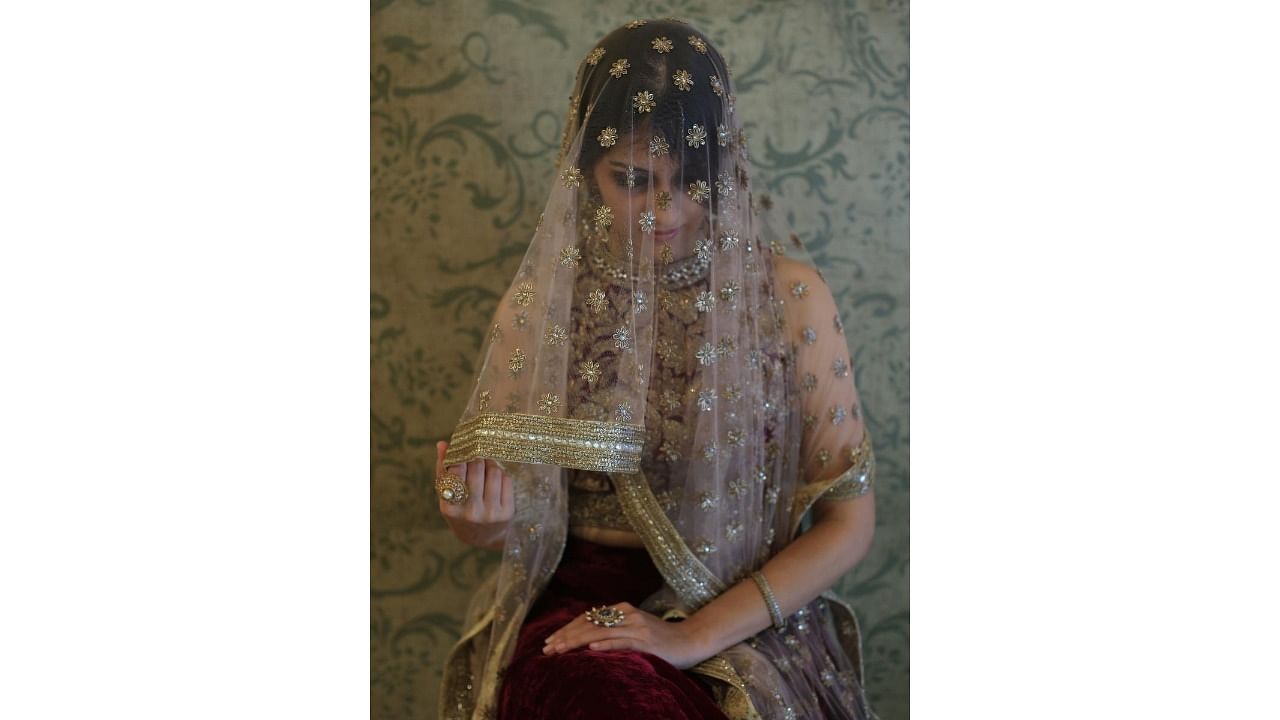

Bollywood actors Alia Bhatt and Katrina Kaif rocked these lacey wonders at their weddings recently. In red, pastels, or white, veils add finesse to an ensemble.
Historically known to represent modesty and purity in weddings, veils are an integral part of the Indian wedding ensemble, be it a north or south Indian wedding. This handing clothing, a necessary add-on to wedding looks, is no longer confined to societal, regional, or religious sentiments.
Bengaluru-based fashion designer Anjali Sharma says, “From the beginning, a veil has been seen as a symbol of respect for all. In India, the veil is a common addition to value systems and traditions, and most brides love a traditional touch to their wedding.” They also love its glam quotient and touch of suspense, she shares.
Veils are now available in different variants. Mumbai-based fashion designer Sheela Suthar, says, “For instance, south Indian brides typically wore only traditional silk saris at one point in time. However, in the last couple of years, they add veils to their ensemble.”
Colours used in veils are no longer monochrome white and beige. Indian brides are now adopting bold colours and details, she adds.
Different looks
Veils now come with different intricate details and unique styles in wedding dresses, according to what the bride wants customised.
Sheela says the veil depends on what kind of look a bride is aiming for. “The most common types are circular veils that are pinned on the head and wrapped around the hem, simple straight veils with borders, and elaborate-panelled veils that flare at the bottom, adding volume to the dress,” she elaborates.
Of late, many brides are opting for two dupattas (veils), one to cover the head and face and another pinned or as a shoulder accessory, Sheela adds.
The length of the veils also varies — ranging from face-framing three-inch blusher veils to floor-skimming cathedral-length veils that can go up to 70 inches or more.
Bengaluru-based designer Riya Kodali observes that Priyanka Chopra’s stunning 75-ft long tulle veil made floor-length veils popular.
“Drop veils are also quite popular with brides. It covers the face during the ceremony and can be pushed back later. Most traditional (Christian) veils are two-tier that have one layer worn at the back of the bride’s head and a second layer, usually waist length, that goes over the bride’s face. Today, brides prefer a single-tier veil that does away with the layer over the face,” she elaborates.
Other types include shoulder-length, elbow-length, fingertip, blusher, birdcage, and ballet-length veils. “The beauty of these delicate cloth pieces complements the look of any bridal gown or lehenga,” she adds.
Likewise, Kochi-based fashion designer Tiya Neil Karikkassery says, ”Floor-length veils are hot favourites among Indian brides as they go with all garments, be it a gown, sari, or a lehenga. These days, the names of the couple are embroidered on the veils.”
What are they made of?
Veils can be made from different fabrics such as net, georgette, chiffon, Chantilly laces, silk, brocade and organza.
Sheela says, “Organza and net are the most sought-after ones as the stiff texture makes them easy to manage. It also gives it volume and bounce. Veils in India are also being made on traditional handwoven fabrics such as Bandini, Ikat, Pochampally, Patan patola, and Banarasi.” These veils can be further customised with lace-work, pearls, motifs, sequins, and zardozi embroidery work, for a unique and personal touch, she adds.
Veils are commonly made from organza, lace, tulle, and net. Riya says these can be further enhanced with light or heavy embellishments. “These days brides normally prefer light embellishments like crystals and pearls. Lace motifs, organza flowers, and beadwork are also seen on them. Pearls give a very modern look whereas crystals provide the shine, particularly at night” she says.
Most popular veils continue to be in white but light ivory, diamond white, and light gold veils are also increasingly gaining demand. “Colours like dark ivory, peach, pink, and pastel colours are also being chosen,” adds designer Riya Kodali.
Beadwork embellishments are popular in Christian weddings, whereas Hindu and Muslim brides mostly opt for intricate zardozi embroidery work and thread work, observes Tiya Neil.
Long process
Depending on how intricate the designs are on a veil, it can take anywhere between 30 to 45 days to create one. “Handwoven traditional fabrics like Ikat, Bandini, Pochampally and Banarasi that require master craftsmen takes time. Embroidery works like zardozi take longer because a lot of intricate detailing goes into it,” says Sheela.
During the wedding season, making a veil could take longer as most designers are pressed for time. “Order for a veil should be placed about three-four weeks in advance. A very heavily embellished veil could even take months to be completed. The veil’s colour can also lengthen the process due to dyeing and polishing the fabric,” says Riya.
Celeb power
“The most remarkable wedding that brought back the trend was of Priyanka Chopra. As for Deepika Padukone, Katrina Kaif, and Alia Bhatt, they have shown that veils look exquisite with any outfit,” says Sheela Suthar.